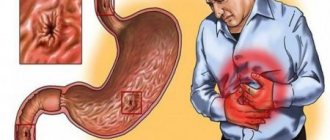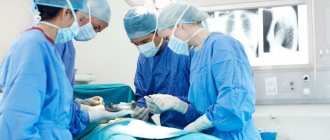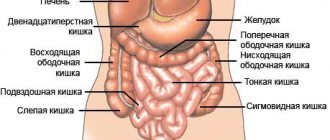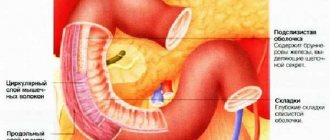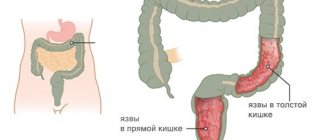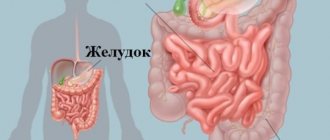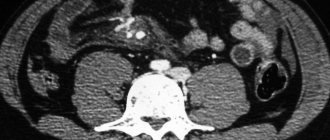General information and classification
Let's take a closer look at what intestinal colonoptosis is. This pathology is manifested by the descent of its thick section onto other abdominal organs. As the disease progresses, not only the digestive, but also the reproductive and urinary systems suffer. Self-diagnosis of this condition is difficult due to the blurred clinical picture, which may indicate other diseases of the gastrointestinal tract. Therefore, for timely detection of colonoptosis, it is necessary to contact a medical institution.
The classification of pathology implies its division depending on the involvement of one or another part of the intestine in the process:
- left-sided colonoptosis - prolapse of the left part of the transverse colon;
- right-sided colonoptosis - prolapse of the right side of the colon;
- total colonoptosis - prolapse of the entire transverse colon.
In addition, in addition to the usual prolapse, transversoptosis is distinguished - sagging of the organ in the shape of the letter V.
Diet for prolapsed bowels
All human organs are located in such a way that they can function normally and not cause harm to each other.
Therefore, any change in position is likely to lead to disruption of their anatomical structure. If there is a suspicion that the intestines have prolapsed, it is recommended to examine the small and large intestines for a more accurate diagnosis. This disease is an extremely unpleasant condition that can cause a variety of diseases, including chronic and acute.
As a rule, the disease is often recognized in the later stages of manifestation, when it is already quite difficult to do anything significant. Therefore, it is important to study the symptoms of the disease and, if they occur, seek help from an experienced professional.
Intestinal prolapse can be a congenital or acquired pathology. As you know, all organs are fixed and supported by certain groups of muscles and ligaments. And if their tone weakens or any disturbances occur, then the internal organs in the abdominal cavity prolapse.
Often the stomach and intestines move together, but there are cases when only one intestine moves down, and this pathology is called “colonoptosis.”
The presence of the disease causes a certain discomfort to a person, which can only be eliminated by a specialist by prescribing the required course of treatment.
Typically, prolapse of the abdominal organs provokes difficulty in removing the contents of the intestines, which, accordingly, is accompanied by frequent constipation.
In this case, the blood circulation process is disrupted, and severe muscle spasms appear. In addition, problems may arise in the functioning of the entire digestive system.
- dull or aching pain in the abdominal area, which can extend to the lower back or pelvis;
- constipation that lasts several weeks;
- the appearance of gas formation;
- nausea and sometimes vomiting;
- apathy and weakness;
- heaviness in the lower abdomen.
In the presence of this disease, signs of damage to the genitourinary system are also often encountered, namely due to the fact that the bladder is compressed, its size decreases, and this leads to frequent urination.
Women sometimes experience pain during the menstrual cycle. But in general terms, all the symptoms lead to stagnation in the blood supply system in the pelvis, which can provoke the development of hemorrhoids.
Reasons that provoke intestinal prolapse:
- genetic predisposition:
- inflammation, which is localized in the tissues of the organ and affects the increase in sprains;
- violation of intestinal muscle tone;
- heavy loads;
- difficult pregnancy;
- operations on other organs.
How and with what is intestinal prolapse treated?
Treatment consists mainly of following a special diet and therapeutic exercises, and only in extreme cases do doctors resort to surgery.
First of all, you will need to relieve the main symptoms and perform the necessary exercises with abdominal retraction, as well as improve the passage of intestinal contents. It doesn't hurt to lead an active lifestyle, take walks and do morning exercises. All this will allow the intestines to work much better. You should also avoid heavy work, heavy lifting and strenuous sports.
How and how to treat intestinal prolapse: effective remedies and drugs
Dietary adherence plays an important role. You need to drink a lot of water and eat plant-based foods that contain fiber.
If necessary, the doctor will definitely add the consumption of laxatives and painkillers to the diet. And in order to correct the position of the internal organs, it is recommended to wear a bandage.
In addition, massage is a good help in treating this ailment, which is strictly prohibited to do on your own and should only be performed by a specialist.
As mentioned above, doctors resort to surgical interventions quite rarely, only in cases of extreme necessity. Surgical treatment consists of creating an artificial connection of the intestine with stronger points of the connective apparatus.
In this case, the anterior abdominal wall is cut, and the surgeon removes and places intestinal loops in the required order, and sews them with surgical threads to the required places. This is considered a very difficult operation, despite the development of medicine and the use of new technologies.
In addition, this type of treatment is difficult for patients to tolerate and can lead to various complications.
Treatment with folk remedies
Through therapeutic exercises that strengthen weakened muscles, you can support the intestines, and in order to combat constipation and flatulence, treatment with traditional methods is well suited.
To do this, you need to take infusions and decoctions of a variety of medicinal plants. In this case, the laxative fruits of joster and hay leaves, which are taken before bed, are suitable. The decoction of joster should be consumed in half a glass, and the water infusion of senna should be drunk exclusively in small sips.
A noticeable effect should occur within a few days. However, such decoctions are not recommended for women during lactation and in the presence of any inflammation or acute intestinal diseases.
Judging by the reviews, you can additionally use buckthorn bark. This remedy also helps well against constipation and is taken in the morning and evening before bed. In turn, an infusion of cumin seeds or ordinary dill and fennel seeds should be drunk a couple of sips throughout the day.
Diet 4 for intestinal diseases is indicated not only for sick people, but also for those who have undergone surgery on the intestinal tract and are undergoing rehabilitation. Table No. 4 provides a specific menu.
When is it prescribed?
Table No. 4 is shown to people:
- Having an intestinal disorder accompanied by diarrhea.
- For stomach diseases (gastritis).
- For intestinal disorders caused by infectious diseases.
- Those with diseases of the gastrointestinal tract (colitis, enteritis, duodenitis, etc.).
- With constipation due to previous intestinal diseases, after eliminating the pathology with medication.
- After treatment of intestinal diseases of any etiology.
- During the period of exacerbation of chronic gastrointestinal diseases. A therapeutic diet is also indicated for pain in the intestines due to chronic diseases, even if this is not an exacerbation, such nutrition simply helps to support the body.
- When treating the intestines surgically in the postoperative period.
Intestinal obstruction, inflammation of the large or small intestine, inflammation of the stomach wall, disruption of the pancreas - for all these pathologies, following a diet is indicated.
If you have problems with the intestines and stomach, it is very important to choose the right nutrition option and table number 4 will be optimal.
It is used to alleviate the patient’s condition and normalize regular bowel movements in case of a diseased intestine.
One of the main causes of constipation and diarrhea is the use of various medications.
.
To improve bowel function after taking medications, you need to drink a simple remedy
.
Features of dietary table No. 4
A sick intestine is a serious problem and only medications will not help solve it completely. Proper nutrition and medication treatment will only add up to a good result. For intestinal pathologies, a gentle diet is indicated to relieve the intestines and give it the opportunity to begin to work actively on its own.
Source: https://limto.ru/dieta-pri-opushhennom-kishechnike/
Causes
Colonoptosis can be either congenital - due to abnormalities in the development of the intestine at the prenatal stage, or acquired - due to the impact on the body of factors predisposing to this disease.
The main processes leading to intestinal prolapse are:
- flaccidity of the abdominal muscles;
- prolapse of the diaphragmatic muscles;
- weakening of the intestinal ligaments.
The above pathological processes provoke the following unfavorable factors:
- errors in the diet - consumption of fatty, fried foods;
- rapid weight loss (due to a strict diet or serious illness);
- being overweight or obese;
- previous laparotomy operations;
- mechanical injuries of the abdominal organs;
- excessive physical activity;
- hormonal imbalances;
- multiple births in women.
There is a high risk of developing colonoptosis in women with rapid labor. Such a pathology can lead to disruption of the integrity of the musculo-ligamentous apparatus of the intestine, and, as a consequence, prolapse of this organ.
Fully or partially limited products
The diet for colonoptosis involves exclusion from the diet:
- Dishes and foods that move slowly through the intestines, dishes with a viscous consistency - pureed porridge, slimy soups, mashed potatoes, jelly.
- Dishes that contain tannins - dogwood jelly, quince, blueberry, pear, bird cherry, cocoa, strong tea/coffee.
- Chocolate and cream products, baked goods made from yeast/puff pastry, bread made from premium flour.
- Foods that cause constipation - potatoes, rice, semolina, vermicelli, noodles, sago, and for flatulence - legumes, cabbage, black bread, bananas, grapes, raisins.
- Difficult to digest foods - fatty red meat and fish, duck, goose, smoked meats, canned food, hard-boiled eggs.
- Spicy foods that irritate the gastrointestinal mucosa (spices, seasonings, sauces).
Symptoms
The disease does not have a characteristic clinical picture, which makes its diagnosis much more difficult. Moreover, it may not show any symptoms for a long time.
The main symptoms of colonoptosis are digestive disorders such as constipation and flatulence. Such manifestations develop due to difficulty in the movement of feces through the pathological part of the intestine, stagnation of which leads to the occurrence of fermentation and putrefaction processes, which causes the formation of gases.
Additional symptoms of prolapse include:
- pain in the abdominal area is initially aching, and as the disease progresses, it becomes intense;
- heaviness in the stomach, loss of appetite;
- feeling of fullness of the stomach due to its compression;
- manifestations of dyspepsia - belching, nausea, vomiting;
- a feeling of discomfort in the abdomen when standing, which goes away after the person lies down;
- the appearance of signs of intoxication - weakness, lethargy, decreased performance, headaches; such symptoms arise due to toxins entering the human body from stagnant feces;
- men may experience dysuric disorders, and women may experience painful menstruation and cycle disorders.
As the pathological process progresses and the colon descends into the small pelvis, complications such as hemorrhoids, anal fissures, rectal prolapse, and inflammation of the urinary system develop.
Transverse colon prolapse
Colonoptosis is prolapse of the colon. The colon is attached to the posterior wall of the abdominal cavity by means of ligaments, which, when weakened or partially torn, sag. Violation of normal spatial orientation changes the functioning of the intestine, its motility and causes symptoms of partial obstruction and fecal intoxication.
Classification
The classification is simple and reflects the anatomical features of the prolapse:
- right-sided colonoptosis - the right side of the colon is prolapsed;
- left-sided – left is lowered;
- total – both sections are displaced.
The condition is differentiated from dolichomegacolon , when the intestine of excess length sags. With ptosis, the length of the intestine and its parts is normal, physiological, only the position in the abdominal cavity is disturbed.
Local signs
These are all the symptoms associated with a violation of the movement of the food bolus:
- bloating caused by interruption of food passage;
- flatulence or excessive gas production;
- constipation that cannot be treated with conventional remedies;
- abdominal pain, somewhat relieved in a horizontal position;
- urinary disorders and even inflammation of the urinary organs due to compression.
Bloating and constipation impair digestion of food, and patients may lose weight due to refusal to eat. Concomitant inflammation of the digestive canal is common.
General signs
These are signs of fecal intoxication due to untimely removal of decay products, as well as disturbances in other organs:
- nausea;
- vomit;
- headache;
- weakness;
- decreased appetite and mood;
- phlebeurysm;
- haemorrhoids;
- menstrual irregularities in women and prostatitis in men.
Conservative treatment
The main task is to restore motor skills and normalize the movement of food, eliminate bloating and constipation. For this purpose, diet, medications, bandages, and physical therapy are used.
Diet
Products that enhance peristalsis are used:
- containing a lot of fiber or dietary fiber - bran bread, raw vegetables and fruits, legumes, nuts, coarse cereals (barley, barley);
- containing organic acids - lactic acid, naturally pickled vegetables, sour juices and fruit drinks;
- sweet dishes;
- meat of old animals containing a large amount of connective tissue;
- carbonated drinks;
- dishes served cold - okroshka, beetroot soup, aspic, ice cream - which stimulate peristalsis due to temperature.
Food should be large in volume, but low in calories. It is useful to eat dishes of contrasting temperatures. Losing body weight and regularly filling the intestines with rough foods helps eliminate constipation.
Medicines
Laxatives are used only as prescribed by a doctor for a short course. They cannot be used often, as addiction to them quickly develops. Anti-inflammatory agents, enveloping agents, and digestive enzymes may sometimes be used.
To improve motor skills, Prozerin is used, a cholinomimetic that improves neuromuscular transmission. After an intramuscular injection, the intestines “come to life” and the condition improves significantly. However, injections must be repeated periodically.
Bandage
This is a medical product whose purpose is to support the abdominal organs. The bandage is an elastic belt, which is selected individually according to size. You need to put it on in bed before getting up, wear it throughout the day, and take it off before going to bed while lying down.
The bandage is most effective for stretching the muscles and white line of the abdomen, which happens after pregnancy and sudden weight loss.
Physiotherapy
Physical exercises are aimed at strengthening the anterior abdominal wall. The movements are something like this:
- from a lying position on your back with a bolster placed under your lower back, lift your straight legs alternately and then together;
- "bike";
- pull your legs bent at the knees towards your stomach and turn your torso left and right;
- from a position on all fours - leaning on your hands, raise your pelvis as high as possible and stand there for several minutes.
Surgery
Used in extreme cases, the operation is abdominal and very complex. Its essence is to suture intestinal loops to weakened ligaments with a non-absorbable thread. The complexity of the operation is that there is no guarantee of a return to health - adhesions may form at the site of the threads, and the ligaments may weaken even more.
Due to the large number of complications, surgical treatment is used less and less.
Prognosis and possible complications
The prognosis is generally favorable; this condition is not life-threatening. Young women may develop infertility due to compression of the pelvic organs, but this is rather a casuistry, and in practice it is extremely rare.
Complications include various inflammatory processes and digestive disorders, which require separate treatment.
Colonoptosis of the intestine - prolapse of the transverse colon
: 12 Nov at 11:07
Pathological changes in internal organs affect not only the general condition of a person, but also the ability to provoke the development of various complications.
In this regard, when the normal arrangement of internal organs is changed due to their prolapse, the consequences of deterioration in health can be very serious. Visceroptosis.
as this disease is called, it can develop either in a single organ or in two or more organs.
Most often, prolapse of various parts of the colon, differing in clinical picture, is observed.
Perhaps its most important section is the colon, which consists of four sections (ascending, transverse, outgoing, sigmoid).
It serves to absorb water and undigested food debris from the small intestine. Prolapse of the colon, known as a colon, is called colonoptosis.
The main reasons for the development of this disease include a defect in the colon formed during intrauterine development, as well as the consequences of certain abdominal operations.
Colonoptosis of the intestine can develop with excessive physical exertion, after a difficult pregnancy.
In addition, obesity or too sudden weight loss, osteochondrosis or curvature of the spine with the intestines very close to the spine can also contribute to the development of the disease.
Source: https://shokomania.ru/opushhenie-poperechno-obodochnoj-kishki/
Diagnostics
To identify colonoptosis, the patient is prescribed a diagnostic complex, which consists of clinical and additional research methods.
Clinical
The attending physician carries out the following clinical diagnostic methods:
- collection of complaints - the most disturbing symptoms are determined, as well as signs indicating intestinal prolapse;
- anamnesis collection - information is collected about the patient’s diet and lifestyle, the duration of clinical symptoms; possible causes and predisposing factors of the disease are identified;
- physical examination of the patient - a general examination of the patient is carried out, during which sagging of the abdominal wall is revealed (even with a normosthenic body type);
- palpation of the abdomen - during this clinical study, the specialist identifies the following signs of coloptosis:
- pulsation of the abdominal aorta in the supine position;
- when the abdominal wall is stretched, the pain syndrome weakens;
- displacement of the pylorus of the stomach.
After clinical diagnosis, the doctor prescribes additional tests for the patient.
Additional
Additional diagnostic measures include laboratory and instrumental studies:
- clinical blood test - signs of possible inflammation and anemia are diagnosed (if there are complications);
- general urinalysis - possible inflammatory processes of the urinary system are identified;
- irrigoscopy - X-ray examination of the intestines with the introduction of contrast - the most informative diagnostic method; allows you to determine the degree of descent of the organ;
- colonoscopy is an invasive diagnostic method that allows you to evaluate the mucous membrane of an organ, determine the stenosis of its lumen, and also take a biopsy for further research;
- histological examination of a biopsy sample is a laboratory method that is carried out to determine the cellular structure of the affected part of the intestine (diagnosis of oncology).
After studying the research results, the attending physician prescribes appropriate therapy.
Colonoptosis of the intestine is prolapse of the transverse colon. Where is the colon located?
Each digestive organ in the human body has its own normal location. The correct location of the stomach and intestines is determined by nature itself.
- Causes
- Symptomatic manifestations
- Diagnostic methods
- Treatment
- Physiotherapy
- Prevention
- on this topic
However, pathological processes may occur in which the gastrointestinal tract organs are displaced, and then their functionality suffers. This phenomenon is considered an anomaly.
In some cases, the entire intestine descends into the small pelvis, and not only its functioning is disrupted, but also almost all organs of the digestive, urinary and reproductive systems begin to suffer.
It can be difficult to independently recognize bowel prolapse, since the symptoms are vague and may indicate other pathologies. Only specialists, through hardware examination, will help diagnose the disease and prescribe competent treatment.
Therefore, if there is any noticeable dysfunction of the digestive excretory organ, you should immediately consult a doctor. He will make an accurate diagnosis and tell you how to restore the organ correctly.
Symptomatic manifestations
Recognizing the symptoms of prolapse can be difficult. But if a number of signs appear indicating pathological changes or prolapse of the small/large intestine, then you should be wary.
Typically the disease is indicated by the following set of symptoms:
- nausea or vomiting;
- regular constipation (special medications usually do not help much);
- flatulence (develops due to stagnation of feces, their fermentation);
- pulling sensations and heaviness in the lower abdomen;
- aching pain in the abdomen of a pulling nature (often radiating to the groin);
- general weakness.
With this pathology, the liver, stomach and pelvic organs also suffer, so dysfunction can be observed on their part too. Almost all organs begin to malfunction.
And also as a result of increased pressure on the anal area, prolapse of the rectum is provoked. This is fraught with its loss and the formation of hemorrhoids.
Diagnostic methods
Intestinal atony: causes and symptoms, diagnosis, treatment Rectocele, what is it in women: causes, symptoms and treatment What is papillitis: causes, symptoms, diagnosis and treatment Cryptitis: causes, symptoms, diagnosis and treatment, prevention Inflammation of the sigmoid colon: causes, symptoms and treatment
To make an accurate diagnosis, doctors need to perform several hardware examination methods at once. But, despite the fact that diagnostics are carried out using modern equipment, only a good specialist can accurately establish the diagnosis.
To examine a patient, the following can be used:
- Ultrasound of the abdominal cavity;
- CT scan;
- x-ray of the peritoneum;
- irrigoscopy.
In some cases, a simple palpation of the abdomen may be sufficient to identify a disorder, but this diagnostic method is only possible if you have an asthenic physique (for thin people).
Carrying out diagnostics
The presence of the above symptoms does not always indicate intestinal prolapse. They may also be characteristic of other diseases. Therefore, in order to prescribe the correct treatment and not harm the patient, you should make sure that the diagnosis is correct.
To do this, you need to go to a specialized medical institution and see a specialist doctor (in this case, a gastroenterologist or surgeon).
An experienced doctor will definitely listen to the patient’s complaints, conduct a thorough examination and palpation of the abdomen, and prescribe a number of modern diagnostic methods.
This may be: Ultrasound (ultrasound examination) of the abdominal organs; CT scan; endoscopy; X-ray of the abdominal cavity. Only the last of them allows you to accurately determine the presence or absence of intestinal prolapse. For the desired effect, this procedure is carried out three to four times in one day with breaks of a couple of hours.
What leads to intestinal prolapse and how does the disease manifest?
Prolapse is the displacement of organs relative to their normal position. This pathology of the large intestine is a problem that anyone can face.
It practically does not depend on age and gender, and many factors and reasons can provoke its appearance. Prolapse of the intestine and rectum is a common phenomenon.
Unfortunately, many do not recognize it immediately, because the symptoms can be confused with many other diseases of the gastrointestinal tract or genitourinary system.
Source: https://alkomir.net/kolonoptoz-kishechnika-opushhenie-poperechno-obodochnoj-kishki-gde-nahoditsya-obodochnaya-kishka/
Treatment
Treatment of colonoptosis is aimed at strengthening the musculo-ligamentous apparatus of the intestine and eliminating unpleasant symptoms. Treatment of the disease involves adjusting the diet and lifestyle, doing physical therapy, taking medications and performing surgery.
Non-drug
Non-drug therapy for colonoptosis is the basis of its treatment. It includes the following methods:
- lifestyle changes;
- specialized diet;
- gymnastics classes;
- wearing a bandage;
- use of folk remedies.
Correction of nutrition and lifestyle
In order to activate intestinal motility and strengthen the ligaments that support it, it is necessary to lead an active lifestyle. It involves daily walks in the fresh air and adequate physical activity. Such measures prevent constipation and improve the general condition of the patient.
The diet for colonoptosis is aimed at preventing constipation and flatulence, as well as accelerating intestinal motility.
The diet includes the following nutritional recommendations:
- inclusion in the diet of products containing coarse plant fibers - bran, unground cereals, raw fruits and vegetables;
- drinking enough water – up to two liters per day;
- limiting foods that provoke flatulence - baked goods, legumes, fresh cabbage, grapes;
- restriction in the diet of foods that slow down intestinal motility - mucous soups and cereals, crushed food;
- The consumption of fatty, spicy foods, marinades, smoked meats, and spices is excluded.
To determine the most suitable diet, it is recommended to seek the help of a doctor. He will create a diet taking into account the course of the disease and the individual characteristics of the body.
Gymnastics and wearing a bandage
Prolapse of the colon can also be treated with the help of physical therapy. Exercise therapy classes are aimed at strengthening the muscles of the anterior abdominal wall, which helps to gradually lift the intestines. A few of the most effective exercises:
- Starting position – lying on your back, cushion under the lumbar region. Next, you need to lift your legs alternately without bending them at the knee joints. You need to do the exercise 5-6 times.
- Exercise “bicycle” (performed in a horizontal position).
- Get into a knee-elbow position, lower your stomach and raise your hips. Stand in this position for 2-3 minutes.
All exercises are performed in a horizontal position, at a calm and measured pace. Sudden movements and turns are unacceptable.
A bandage for intestinal prolapse is used to correct its position and prevent further prolapse. This device is an elastic belt that is worn on the abdominal wall. Its use greatly facilitates the patient’s condition and life and helps to gradually raise the transverse colon. It is recommended to wear the bandage all day, putting it on in the morning and taking it off in the evening. The manipulation is carried out in a lying position.
Folk remedies
Treatment with folk remedies helps the patient cope with constipation and flatulence, and also stimulates intestinal function.
The most common recipes are:
- A decoction of medicinal herbs. Ingredients: wormwood and yarrow leaves. Preparation: chop and mix the plants in equal proportions. Then pour 30 g of the mixture into 250-300 ml of boiling water and keep in a water bath for several minutes. Application: strain, dilute with a glass of water and drink 15 ml 3 times a day before eating.
- Infusion of medicinal herbs. Ingredients: dill, fennel, cumin. Preparation: mix the plants in equal quantities, pour 50 g of the mixture with a liter of hot water and leave for several hours. Application: consume 15 ml, drinking 1 glass of infusion during the day.
- Buckthorn decoction. Ingredients: buckthorn bark Preparation: chop the bark, add 15 g to 200 ml of boiled water and put on low heat. Wait until half of the broth has evaporated. Application: dilute the decoction with water in a 1:1 ratio, drink 100 ml 2 times a day.
Medication
At this stage, therapy for colonoptosis involves taking medications. If all of the above methods are ineffective or complications occur, surgery is prescribed.
Conservative
Symptoms and treatment of the disease with medications are closely related. Medicines prescribed for colonoptosis are aimed at eliminating its unpleasant manifestations.
Symptomatic treatment is carried out using the following medications:
- Antispasmodic drugs - aimed at relaxing long-term contracted muscle fibers of the organ: Droteverine, No-shpa, Platyfillin, Papaverine.
- Analgesics – eliminate severe pain: “Ketorol”, “Analgin”, “Ketorolac”, “Ibuklin”.
- Sorbents and carminative medications – reduce the phenomenon of flatulence: “Sab Simplex”, “Espumizan”, “Enterosgel”, “Smecta”.
- NSAIDs - prescribed when inflammatory processes occur: Nurofen, Diclofenac, Ketoprofen, Meloxicam.
Taking laxatives for colon prolapse is not recommended. These drugs have a tendency to become addictive, which can further worsen the movement of feces through the intestines. Usually, a properly selected diet helps eliminate constipation.
Surgical
Surgical treatment of colonoptosis is prescribed only in extreme cases. Indications for surgical intervention are the following situations:
- ineffectiveness of other treatment methods;
- rapid progression of the disease;
- prolapse of the intestine into the pelvis;
- intestinal bleeding;
- intestinal obstruction;
- rectal prolapse;
- circulatory disorders of the digestive organs.
The operation consists of creating several additional loops of ligature threads, with the help of which the specialist fixes the intestines to the strongest places in the abdominal cavity. But surgical intervention is dangerous due to the development of a complication such as adhesive disease - this condition can aggravate the course of the disease. Therefore, surgery for colonoptosis is used only if all other methods of therapy are ineffective.
Colonoptosis of the colon
Pathology of the digestive system often affects not only the general condition of the body, but also causes a number of different complications. That is why all organs of the gastrointestinal tract need regular and high-quality diagnostics.
Malaise can be caused by various sources, which may include both infectious diseases and a condition such as prolapse of internal organs.
Today, colon prolapse, known in medical practice as colonoptosis, is quite common.
Description of the clinical picture and pathogens
The colon, known as the colon, is a section of the large intestine and consists of four parts: ascending, transverse, descending and sigmoid. The colon serves to absorb water and undigested parts of food that enter it from the small intestine.
A disease such as colonoptosis develops when the fixing ligaments that attach the colons to the posterior wall of the peritoneum are weakened. The main reason is a congenital defect of the colon. However, in some cases external factors lead to omission.
Colonoptosis can develop due to heavy lifting, excessive exercise, removal of bulky tumors, after pregnancy, or removal of fluid from the abdominal cavity due to ascites.
Frequent symptoms of the disease are pain in the intestinal area, especially after physical activity. As a rule, the discomfort goes away if you take a horizontal position.
Sometimes there are stool disturbances and bloating. If colonoptosis reaches a more severe stage, then nausea and vomiting and loss of appetite appear.
Due to constipation, fecal intoxication occurs and the patient may suffer from intense headaches.
Complications of colonoptosis are quite serious. As a result of colon prolapse, there is a disruption in the passage of feces and intestinal motility.
In particular, a prolapsed, full colon puts high pressure on the organs of the genitourinary system. As a result, there is a disruption in their work, inflammation, which in turn can lead to infertility.
Also, the disease is often accompanied by intestinal obstruction, diseases of the stomach, liver and other organs of the digestive tract.
Types of diseases and features of treatment procedures
Today, there are several types of colonoptosis, which are most often found in modern medicine. Right-sided colonoptosis is a prolapse of the right colon, which sometimes involves other organs.
However, the most severe case of the disease is total colonoptosis, when all parts of the colon descend into the pelvic area.
Symptoms of different forms of the disease may be similar, but an accurate diagnosis can only be made with the help of professional equipment.
The main principle of treating the disease is the restoration of intestinal motility. First of all, the doctor prescribes a balanced diet, which normalizes intestinal function.
In addition, a special diet is necessarily accompanied by therapeutic exercises, which are carried out in groups at a medical institution. The patient can perform some exercises at home independently, and the main rule is regularity.
Moderate physical activity will help balance the motility of internal organs and improve the overall condition of the digestive system.
Also, the treatment complex for colon prolapse includes regular injections of proserin. This drug is aimed at improving muscle-nervous conduction and has a wide range of applications.
It effectively improves intestinal tone and strengthens the ligaments that keep the colon from progressing to ptosis.
Prozerin is prescribed exclusively by prescription and has a number of contraindications, including bronchial asthma, epilepsy, atherosclerosis and severe angina.
Treatment of this intestinal disease is also carried out using electrical stimulation, acupuncture and acupressure. An integrated approach to therapeutic measures makes it possible to provide an effective effect on the gastrointestinal tract and relieve the patient from the manifestations of the disease in a short time.
Diagnostics and prevention
The most effective method for identifying colonoptosis at an early stage is irrigography. This technology is based on the use of X-ray equipment to analyze the condition of the colon.
During the diagnostic process, a contrast agent is injected into the patient's body through an enema, after which an image of the corresponding part of the intestine is taken. Irrigography allows you to assess the size of the colon, its position and functional features. Irrigography requires careful preparation and is prescribed mainly to adult patients.
Before the procedure, the patient should drink plenty of water and thoroughly cleanse the intestines the day before.
Experts say that the most effective method of treating the disease is timely preventive measures.
In particular, if you do not have a hereditary predisposition to prolapse of the digestive system, then you should avoid excessively intense sports and do not lift heavy objects.
Meanwhile, if you are predisposed to this disease, then you are advised to follow a balanced diet, eating foods that stimulate the intestines.
Source: https://enterolog.ru/tolstaya-kishka/obodochnaja/kolonoptoz/
False (training) contractions
One of the most important signs that your uterus is preparing itself for an upcoming event is the appearance of “harbinger” contractions. They are usually not painful and feel more like severe muscle tension. At this moment, the stomach seems to “turn to stone” and shrink, and then gradually relaxes. The main sign by which such contractions can be distinguished from true ones is their irregularity. They occur at random, unequal intervals - sometimes the uterus contracts several times a day, sometimes a couple of times a week. Most often, pregnant women note the appearance of such training contractions in the mornings or evenings.
Siblings' experience:
Margarita
— About 3 days before giving birth, I had false contractions in the morning—I even woke up from them. They were not strong, but rhythmic, at intervals of 10 minutes, lasting for 2 hours. Another interesting phenomenon - during the week before giving birth, when driving a car, when jumping on bumps, I apparently had a strong sensation of pain in the cervix area. Apparently, this is how the neck opened slightly.
e-Katherine
— My training contractions started within 2 weeks. The interval reached 10 minutes, and after 1-2 minutes they stopped. I started writing down the time every time. Same thing on the day of birth: in the morning I woke up in pain, well, I think it was training again. Went to the shower. And then I realized that after a shower it doesn’t get any easier (and usually training contractions go away after a shower), that I got sick about five times while I was washing.
murr1
